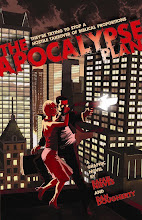It has been a positively massive few weeks in the topic of Religion & Comics, particularly in terms of Islam and Western culture, and a bevvy of links and stories bear highlighting, even en mass. In no particular order:
- PBS will be airing a documentary on the rise of The 99 and the endeavors of its creator Dr. Naif al-Mutawa on Thursday, October 13th at 10 p.m. EST. Blogcritics.org has a brief overview of the show, entitled Wham! Bam! Islam!, as part of the new season of Independent Lens.
- Perhaps on the flip-side of The 99‘s message, Tom Spurgeon at The Comics Reporter relays a news story from the India Express on the arrest of cartoonist Harish Yadav (a.k.a. Mussaveer) on the charge of insulting Muslims with his work. Yadav was released later that day, apparently none the worse for wear, unlike Syrian cartoonist Ali Ferzat who was beaten for his outspoken opposition to his local regime.
- Al Jazeera has published the reaction of University of California – Irvine Professor Mark LeVine on the emergence of superhero Captain Israel by Arlen Schumer. LeVine says, “Turns out – as far as I can tell – this comic is not a prank dreamed up by the Daily Show’s writing team during their summer hiatus, or even more plausibly, by a couple of bored Hebrew School students. ‘Captain Israel’ means business! His task: Defend Israel at all costs from her most dangerous enemies!”
- The concurrent releases of Frank Miller’s Holy Terror and Craig Thompson’s Habibi during the 10-year anniversary of the September 11th terrorist attacks have gotten a great deal of notice in a number of distinct ways. NPR’s “On Point with Tom Ashbrook” dedicated an hour to Thompson and his latest effort, paying particular attention to the 600+-page graphic novel in terms of love and sexuality. (Moreover, of particular interest may be the Comments section for the broadcast’s web page.) Taking a different slant, Robot 6 over at ComicBookResources.com quoted writer G. Willow Wilson’s take on Habibi, praising Thompson’s effort and its beauty but also that “some of Thompson’s attempts to invert cliché get away from him.” Islamicate.org‘s Hussein Rashid also points to Wilson’s take on Habibi, that the book is more about mysticism and the Qur’an than about Islam: “I found myself wondering about the author’s own spiritual journey. How did Thompson, raised a conservative Christian, come to be interested in the mysticism of the Qur’an? That’s a book I’d read, if he were ever inclined to write it.”
Meanwhile, Miller’s work has garnered much more alarm. When Miller moved the project from DC Comics (perhaps with their blessing) to the new Legendary Comics imprint from Legendary pictures, the anti-terrorism graphic novel shifted from featuring the DC-owned Batman to Miller’s new vigilante, The Fixer. Wired magazine has called the terrorist-bashing extravaganza “fodder for the anti-Islam set,” and David Brothers of Comics Alliance calls it, for all Miller’s artistry, “a hateful, ill-considered, simplistic, ugly, nasty little book.” At the same time, though, Pakistani writer Avirook Sen with The International Express online says that “if this was serious, they wouldn’t just give the most important job of our times to some newborn superhero with a second-rate name.”

 A portion of
A portion of 

